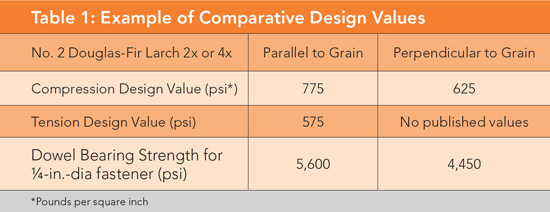Connection Options for Wood-Frame and Heavy Timber Buildings
Learning Objectives:
- Describe the basic categories of mechanical and joinery connections for modern wood structures, and their application in both light wood-frame and heavy timber construction.
- Examine the wide range of connection options available today, from traditional joinery methods to widely used fasteners and connectors to the innovative proprietary connection systems that are enabling longer wood spans, higher walls and taller buildings.
- Apply practical and technical design guidance to ensure effective performance of connections in wood structures.
- Discuss key considerations for selection and installation of connections, for best performance and to avoid potential problems.
Credits:
This course is approved as a Structured Course
This course can be self-reported to the AANB, as per their CE Guidelines
Approved for structured learning
Approved for Core Learning
This course can be self-reported to the NLAA
Course may qualify for Learning Hours with NWTAA
Course eligible for OAA Learning Hours
This course is approved as a core course
This course can be self-reported for Learning Units to the Architectural Institute of British Columbia
The use of wood as a structural material continues to grow far beyond traditional applications, such as single-family homes and buildings up to four stories. Although recent attention has focused on the possibility of wood high-rises, wood’s cost-effectiveness, versatility and light carbon footprint are already making it a material of choice for an expanding range of building types—from innovative public, educational and corporate structures that utilize mass timber products as their main architectural expression, to five-story (and higher) multi-family projects built with dimension lumber using long-established techniques. An essential element common to all of these buildings is effective connections.
In wood buildings, effective connections provide strength, stiffness, stability and ductility in addition to providing a continuous load path to the foundation. They are critical to building performance—under regular loads, and especially during extreme events such as hurricanes and earthquakes. According to post-disaster surveys, structural failures during these events are often due to faults in connection design or assembly.
This continuing education course provides an overview of connection options for modern wood structures, both light wood-frame and heavy timber (see glossary). It covers mechanical connections—including dowel, shear and metal connector plates with integral teeth—and joinery connections, as well as proprietary connections that are in many ways supporting the current surge in innovative wood design. Proper selection and installation, and ways to avoid potential problems, are also discussed.

Photo: Robert Benson Photography
Portland Jetport, Portland, Maine
Architect: Gensler
Southern pine glulam was chosen for this 40,000-sf roof because of its ability to span long distances with minimal need for intermediate supports.
Wood Connection Basics
To determine the most appropriate connection for a given application, it is necessary to understand certain fundamentals, starting with the terminology. In this continuing education course, a connection encompasses all of the components that attach one part of a building element to another, be it wood to wood, wood to steel or wood to another material. Within the connection are connectors and/or fasteners. Metal hangers, column bases and many other products fall within the category of connectors. Fasteners include (among others) nails, screws, timber rivets and bolts. These products do the ultimate work of fastening the elements of a connection, either with additional connectors (such as hangers) or on their own.
Several characteristics of wood are also relevant to overall connection behavior.
First, wood is anisotropic, meaning it has different strength properties in different directions: longitudinal (strong), tangential (weaker) and radial (weakest).

- Wood is stronger in compression and tension parallel to grain versus perpendicular to grain; the former is the preferable way of designing wood connections. However, this is not always practical or possible.
- While wood is weaker in compression perpendicular to grain, this is the most common way to transfer loads in construction. The most common loads are gravity loads, and the typical way to transfer them is in bearing—thus reliance on the compression perpendicular to grain properties of wood. Fasteners and connectors are required to transfer other loads, such as wind uplift and the lateral loads caused by occasional wind and seismic forces to provide a continuous load path to the foundation.
While capacities are more limited when wood is loaded in compression perpendicular to grain (versus parallel to grain), the limits for bearing conditions on the surface of wood members are deformation-based, not strength-based, and published design values can be increased for smaller bearing areas. Accordingly, dowel bearing strengths are higher relative to compression parallel or compression perpendicular to grain values. However, dowel bearing strengths perpendicular to grain are lower relative to dowel bearing strengths parallel to grain for larger diameter (less than ¼ in.) fasteners (see Table 1).
- Wood is weakest when tension is applied perpendicular to grain. This should be avoided—which is why there are no published design values for tension perpendicular to grain.
Second, wood connections are stronger when the load is spread over a number of fasteners. Large concentrated loads should be avoided unless designed not to exceed the wood’s strength capabilities (e.g., net tension and shear). Spreading the load also builds in a degree of redundancy, which is useful in high-wind or seismic events. To accomplish this, designers are advised to:
- Use small fasteners (less than ¼ in. dia).
- Use multiple fasteners when possible.
- Keep the scale of fasteners relative to the size of wood members being connected.
Third, as with other building materials, wood moves in response to environmental conditions. The main driver for this movement in wood is moisture. Allowances must be made to accommodate potential shrinkage and swelling, particularly in connections. (See Moisture Effects on page 6.)















